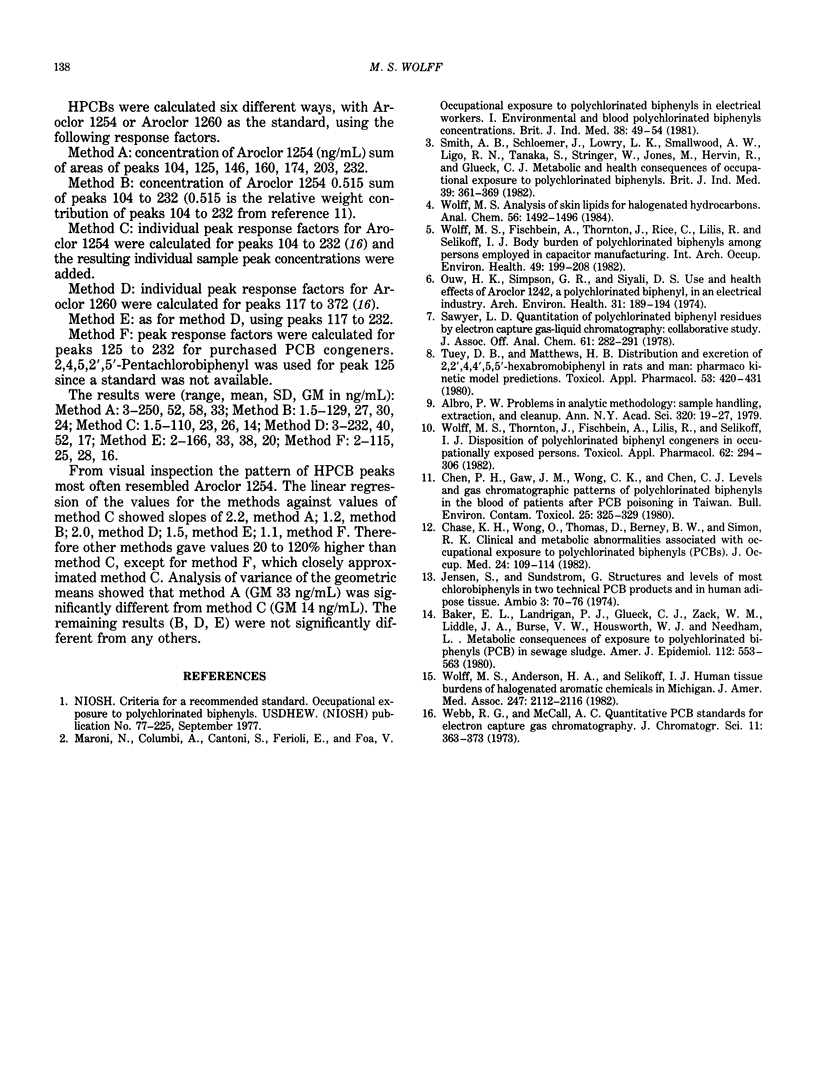Abstract
Human occupational exposure to polychlorinated biphenyls (PCBs) with varying chlorine content has been reported by several investigators, using analyses of blood or adipose samples or skin wipes to evaluate levels in the body. The intensity of occupational exposure is related to both duration and intensity of exposure. The qualitative nature of occupational exposure, as well as casual environmental exposure, has been shown to consist of less readily metabolized PCB congeners. The pattern of PCB congeners in human tissues, determined by gas chromatography, may or may not be readily ascribed to specific PCB standard mixtures. The average occupational exposure, as depicted in several studies of blood, plasma or serum concentrations, is approximately 10 to 1000 times that observed in nonoccupationally exposed persons. Currently used methods of PCB quantitation and pattern identification vary widely, with no uniformly administered criteria being applied to characterize human PCB exposure.
Full text
PDF





Selected References
These references are in PubMed. This may not be the complete list of references from this article.
- Baker E. L., Jr, Landrigan P. J., Glueck C. J., Zack M. M., Jr, Liddle J. A., Burse V. W., Housworth W. J., Needham L. L. Metabolic consequences of exposure to polychlorinated biphenyls (PCB) in sewage sludge. Am J Epidemiol. 1980 Oct;112(4):553–563. doi: 10.1093/oxfordjournals.aje.a113024. [DOI] [PubMed] [Google Scholar]
- Chase K. H., Wong O., Thomas D., Berney B. W., Simon R. K. Clinical and metabolic abnormalities associated with occupational exposure to polychlorinated biphenyls (PCBs). J Occup Med. 1982 Feb;24(2):109–114. [PubMed] [Google Scholar]
- Chen P. H., Gaw J. M., Wong C. K., Chen C. J. Levels and gas chromatographic patterns of polychlorinated biphenyls in the blood of patients after PCB poisoning in Taiwan. Bull Environ Contam Toxicol. 1980 Aug;25(2):325–329. doi: 10.1007/BF01985533. [DOI] [PubMed] [Google Scholar]
- Maroni M., Colombi A., Cantoni S., Ferioli E., Foa V. Occupational exposure to polychlorinated biphenyls in electrical workers. I. Environmental and blood polychlorinated biphenyls concentrations. Br J Ind Med. 1981 Feb;38(1):49–54. doi: 10.1136/oem.38.1.49. [DOI] [PMC free article] [PubMed] [Google Scholar]
- Ouw H. K., Simpson G. R., Siyali D. S. Use and health effects of Aroclor 1242, a polychlorinated biphenyl, in an electrical industry. Arch Environ Health. 1976 Jul-Aug;31(4):189–194. doi: 10.1080/00039896.1976.10667218. [DOI] [PubMed] [Google Scholar]
- Sawyer L. D. Quantitation of polychlorinated biphenyl residues by electron capture gas-liquid chromatography: collaborative study. J Assoc Off Anal Chem. 1978 Mar;61(2):282–291. [PubMed] [Google Scholar]
- Smith A. B., Schloemer J., Lowry L. K., Smallwood A. W., Ligo R. N., Tanaka S., Stringer W., Jones M., Hervin R., Glueck C. J. Metabolic and health consequences of occupational exposure to polychlorinated biphenyls. Br J Ind Med. 1982 Nov;39(4):361–369. doi: 10.1136/oem.39.4.361. [DOI] [PMC free article] [PubMed] [Google Scholar]
- Tuey D. B., Matthews H. B. Distribution and excretion of 2,2',4,4',5,5'-hexabromobiphenyl in rats and man: pharmacokinetic model predictions. Toxicol Appl Pharmacol. 1980 May;53(3):420–431. doi: 10.1016/0041-008x(80)90355-5. [DOI] [PubMed] [Google Scholar]
- Webb R. G., McCall A. C. Quantitative PCB standards for electron capture gas chromatography. J Chromatogr Sci. 1973 Jul;11(7):366–373. doi: 10.1093/chromsci/11.7.366. [DOI] [PubMed] [Google Scholar]
- Wolff M. S. Analysis of skin lipids for halogenated hydrocarbons. Anal Chem. 1984 Jul;56(8):1492–1496. doi: 10.1021/ac00272a064. [DOI] [PubMed] [Google Scholar]
- Wolff M. S., Anderson H. A., Selikoff I. J. Human tissue burdens of halogenated aromatic chemicals in Michigan. JAMA. 1982 Apr 16;247(15):2112–2116. [PubMed] [Google Scholar]
- Wolff M. S., Fischbein A., Thornton J., Rice C., Lilis R., Selikoff I. J. Body burden of polychlorinated biphenyls among persons employed in capacitor manufacturing. Int Arch Occup Environ Health. 1982 Feb;49(3-4):199–208. doi: 10.1007/BF00377929. [DOI] [PubMed] [Google Scholar]
- Wolff M. S., Thornton J., Fischbein A., Lilis R., Selikoff I. J. Disposition of polychlorinated biphenyl congeners in occupationally exposed persons. Toxicol Appl Pharmacol. 1982 Feb;62(2):294–306. doi: 10.1016/0041-008x(82)90128-4. [DOI] [PubMed] [Google Scholar]


